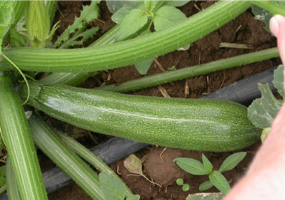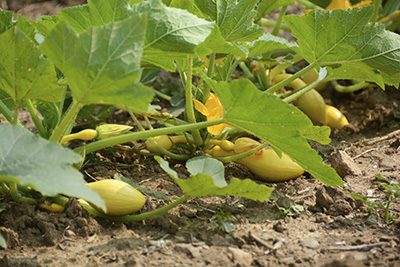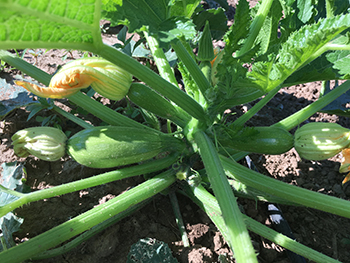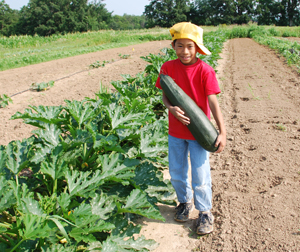 Zucchini
Zucchini Yellow or Crookneck Summer Squash
Yellow or Crookneck Summer Squash Mediterranean Zucchini also called Middle Eastern Zucchini or Gray Squash
Mediterranean Zucchini also called Middle Eastern Zucchini or Gray Squash The dreaded "zucchini log". Zucchini this size are useful for zucchini bread and entertaining small children.
The dreaded "zucchini log". Zucchini this size are useful for zucchini bread and entertaining small children.There is an old joke that goes something like this. If you park your car in a suburban neighborhood in August, be sure to lock it. If you don't, someone will put zucchini in it. Another saying is that you can't plant the right amount of zucchini in a back yard garden. If you only plant one, it will die. If you plant two, you will have far too much zucchini. Zucchini grows very rapidly, and if left on the vine more than a few days, will become very large, the seeds will mature and the skin will lose its gloss and become tough. In short it will become a zucchini "log". This isn't necessarily bad if you like zucchini bread. But how much zucchini bread can a person eat?
It is easy to make jokes about zucchini because they progress from blossom to "log" in very few days. And the most desirable stage for all but zucchini bread-makers is immature fruit with glossy, tender skin. Even though we joke about this much maligned vegetable, it is very popular, and a wonderful addition to a wide range of dishes.
Many cultures use zucchini, each in its own ways. In some cases, the color or the shape of the fruit makes a difference. In the U.S. Midwest, the most popular zucchini are dark, long and slender. Any size will usually do, as long as the fruit is still young and glossy. In the Middle East, the preferred zucchini are lighter, a pale gray-green, short, and slightly plump. The reason? Some Middle Eastern recipes call for stuffing the zucchini. A special coring tool is used to hollow the fruit for stuffing. What The Tree Farm calls Mediterranean Zucchini (also called Middle Eastern Zucchini or Gray Squash) have to be the right size and shape for the coring tool to work properly. Elsewhere in the Mediterranean Basin some folks want their zucchini with the flowers still attached. Some people just want the flowers! (We have always marveled at the courage of people who pick zucchini flowers. Bees love them, and sometimes get caught when the flowers are picked. On more than one occasion, we have watched customers gently evict bees from the flowers, one flower at a time.)
To yet another group, most frequently from the U.S. South, zucchini is OK, but they want "squash". To Northerners, "squash" often means winter squash, the kind picked mature that stores well for use in the winter. But not to some Southerners. In their vocabulary, squash means yellow squash, preferably yellow crookneck squash (not "those straight things" that have been bred to fit into shipping containers more efficiently). Crookneck squash has a flavor very similar to zucchini, with a slightly "nuttier" flavor for some. Some people use them interchangeably, others have to have one or the other. (Zucchini, Mediterranean Zucchini and crookneck squash are all, of course, squash. They are types of squash that are used at the immature stage - except for zucchini bread, that is.)
Zucchini and crookneck squash can be picked by grasping the fruit near the stem end and gently twisting and pulling the fruit. Some people prefer to use a knife to cut the stem. The vines, particularly zucchini and crookneck are covered with relatively soft spines. Some tough-skinned people are not bothered by these spines. Others are more comfortable wearing long sleeves and gloves to pick these vegetables.
Zucchini and yellow crookneck squash are usually ready some time in early to mid July at The Tree Farm. The plants usually stop bearing by mid September.
Zucchini is used in hundreds of ways. It can be dipped in an egg batter, breaded and fried. It can be stuffed. It can be eaten raw with a veggie dip. It can be grilled, pickled, used as an ingredient in omelets, casseroles, stir fries, soups, cakes, breads, cookies and any number of other ways. We enjoy it prepared in many ways. Among our favorites are sauteed zucchini and Karen's zucchini soup.
Unpicked zucchinis continue to grow to sizes that we refer to as 'logs'. They are good for making zucchini bread or any recipe that calls for grated zucchini. Peel the logs, scrape out the seeds, then grate the flesh. You will have an ample supply for many loaves of delicious zucchini bread or zucchini pancake.
Basic ingredients
Two or three sliced medium zucchini
1/2 to one cup grated Parmesan cheese (to taste)
Optional ingredients, any or all may be used
Clove garlic (chopped)
Medium onion (chopped)
Chopped pepper (bell, Cubanelle, Anaheim or pepperoncini)
1/4 cup chopped ham or other cured meat
Saute vegetables and meat until the zucchini is tender. Stir in Parmesan cheese immediately before serving.
Soup Base
Fill a large kettle half full of coarsely chopped zucchini. (Large zucchini work for this as long as their skin is still glossy.) Fill to the top with cored cut up tomatoes. (Because no water is added, it is important to use juicy tomatoes. Pink tomatoes are our preference. Red or yellow tomatoes will also do. Paste or Roma tomatoes aren't juicy enough and should not be used in this recipe.) Heat slowly with occasional stirring to release juices from the zucchini and tomatoes as the mixture comes to a boil. Cook uncovered until the zucchini is soft and the mixture is well blended. This is the base for zucchini soup. Karen either freezes this soup base or uses it immediately to make soup.
Zucchini Soup
To make the Zucchini Soup Base into soup, add onions, salt, perhaps a hot pepper or black pepper, and a pinch or two of celery seed. Then, clean out the refrigerator. Add small amounts of just about anything. Something with a little ground beef in it is good, perhaps leftover spaghetti sauce, or a hamburger cut up into small pieces. (Or brown a small amount of ground beef to add.) Karen sometimes includes carrots, a little bit of potato, some eggplant, maybe a turnip or parsnip, some daikon, rice or barley, noodles, grated cheese, corn, peas, beans, lettuce, spinach, mustards or other greens, broccoli, cauliflower, cucumbers, etc. Almost anything in the refrigerator can go in. Karen may add other spices after tasting the gemisch, possibly basil, oregano, dill, etc. The soup is always good, and different every time!
The Tree Farm
The Pick-your-own Vegetables Place
www.thetreefarm.net
In Northwestern Dane County, Wisconsin, serving Madison and the surrounding area
8454 State Road 19
Cross Plains, WI 53528
608.798.2286
farm@thetreefarm.net
Updated May 07 2017
Copyright © 2004-2025 UPPER LLC dba The Tree Farm. All Rights Reserved.